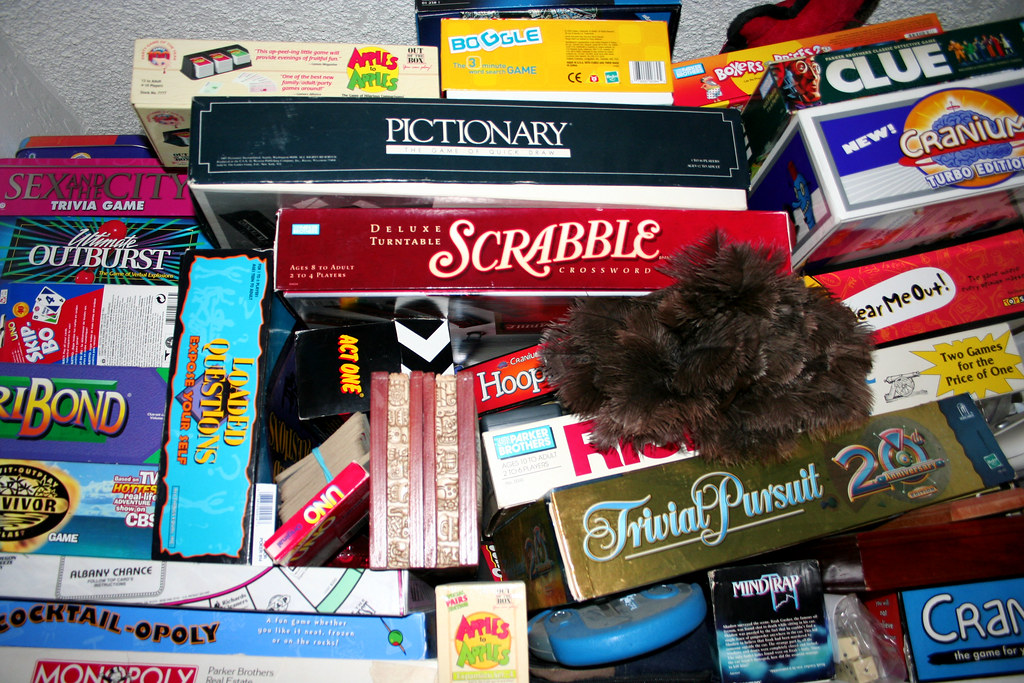
How many puzzles does it take to make it through quarantine? For my family, apparently 10 1,000 piece puzzles, four 3-D puzzles and counting. One puzzle was so difficult we may jokingly frame it (gasp!) with the caption being “The worst puzzle of Quarantine 2020.” And let’s not forget about the many board and card games we played to increase our pastime possibilities.
I have never been much of a game player, but even I succumbed during the boredom of quarantine. It made me wonder about the pastimes of people before modern technology made games so affordable and easy to obtain. Archaeologists continue to unearth many types of games; recently a 1,700 year-old Roman game was found in a burial ground. It is thought to be an ancient version of backgammon. I decided to do my own dig through the library’s collection and I found many books on the history and rules of games past and present.
If you would like to do a little digging yourself, you might want to start with this rather quixotic title, “Fox Tossing, Octopus Wrestling And Other Forgotten Sports” (Touchstone, 2015) by Edward Brooke-Hitching. While some of the games mentioned were very mean-spirited, such as fox tossing, which involves a large slingshot and a fox, the book demonstrates that humans do not like to be bored. I assume that only true boredom could lead people to create pastimes such as baseball with a cannon (ouch!)” and dwile-flonking (think drinking and beer-soaked rags). This sometimes hilarious book highlights games and pastimes created by humans – many been created out of sheer boredom.
Although I tend to stay away from this one, Monopoly is a much-loved board game with many different versions, such as Bacon-opoly and a cat lover’s edition. First popularized in America in 1935, Monopoly is now played all over the world. But there is a more lengthy and somewhat dark history of the game highlighted in Mary Pilon’s fascinating book, “The Monopolists: Obsession, Fury and Scandal Behind the World’s Favorite Board Game” (Bloomsbury USA, 2015). According to Pilon, the game was actually invented by a woman more than 30 years before Parker’s Brothers version existed and there is a history of obsessive, unethical machinations that took place to “monopolize” the game.
Though my whole family did puzzles together, we noticed that each of us had a slightly different approach. Apparently, this is common and Margaret Drabble’s memoir “The Pattern in the Carpet: A Personal History with Jigsaws” (Houghton Mifflin Harcourt, 2009), offers some insight. Drabble mixes fun tidbits and historical facts about the educational beginnings of the hobby with her own personal history, highlighted by her relationship with her aunt and a diverse look at jigsaw puzzles. Get a cup of tea and curl up in your favorite chair for this one.
Did you know the game of chess did not have a queen for the first 500 years of its’ existence? Marilyn Yalom’s book, “The Birth of the Chess Queen” (Harper Collins Publishers, 2004) focuses on the games early history and how it mirrored the political and social environment of medieval queens. She believes the chess queen’s evolution from a minor piece to the powerful piece she is today was influenced by medieval queens and rulers such as Eleanor of Aquitaine, Margaret of Denmark, and Catherine the Great. Yalom has provided an interesting look at the political and social climate of that period and its possible influence on the history of the game. Even if you have never played chess, but love the quirks of history, this book is for you.
Crosswords puzzles are supposed to be excellent brain games, which is apparently something my children think I could use. I have not taken them up, yet, but reading about this 100-year-old activity does seem interesting. Alan Connor digs into that history in “The Crossword Century; 100 Years of Witty Wordplay, Ingenious Puzzles, and Linguistic Mischief” (Gotham Books, 2014). The game seemed to take off in 1924 with the publication of the first puzzle collection by a new publishing house known today as Simon & Schuster. Each chapter of this book reads as a personal essay on different aspects of the game with crosswords and puzzles hidden throughout the game — even chapter titles are part of a crossword puzzle.
Finally, if you are a stickler for the “rules” (as my husband is), you might want to take a look at “The Big Book of Rules: Board Games, Kids’ Games, Card Games, From Backgammon and Bocce to Tiddlywinks and Stickball” (Plume, 2005) by Stephanie Spadaccini. From frisbee golf to hearts, Spadaccini covers the rules for more than 300 games. Want more? Keep digging for information about games and pastimes with these books.
Literary Links, compiled by library staff, appears monthly in the Ovation section of the Columbia Daily Tribune. Each article contains a short list of books on a timely topic.
Read more from Literary Links.


